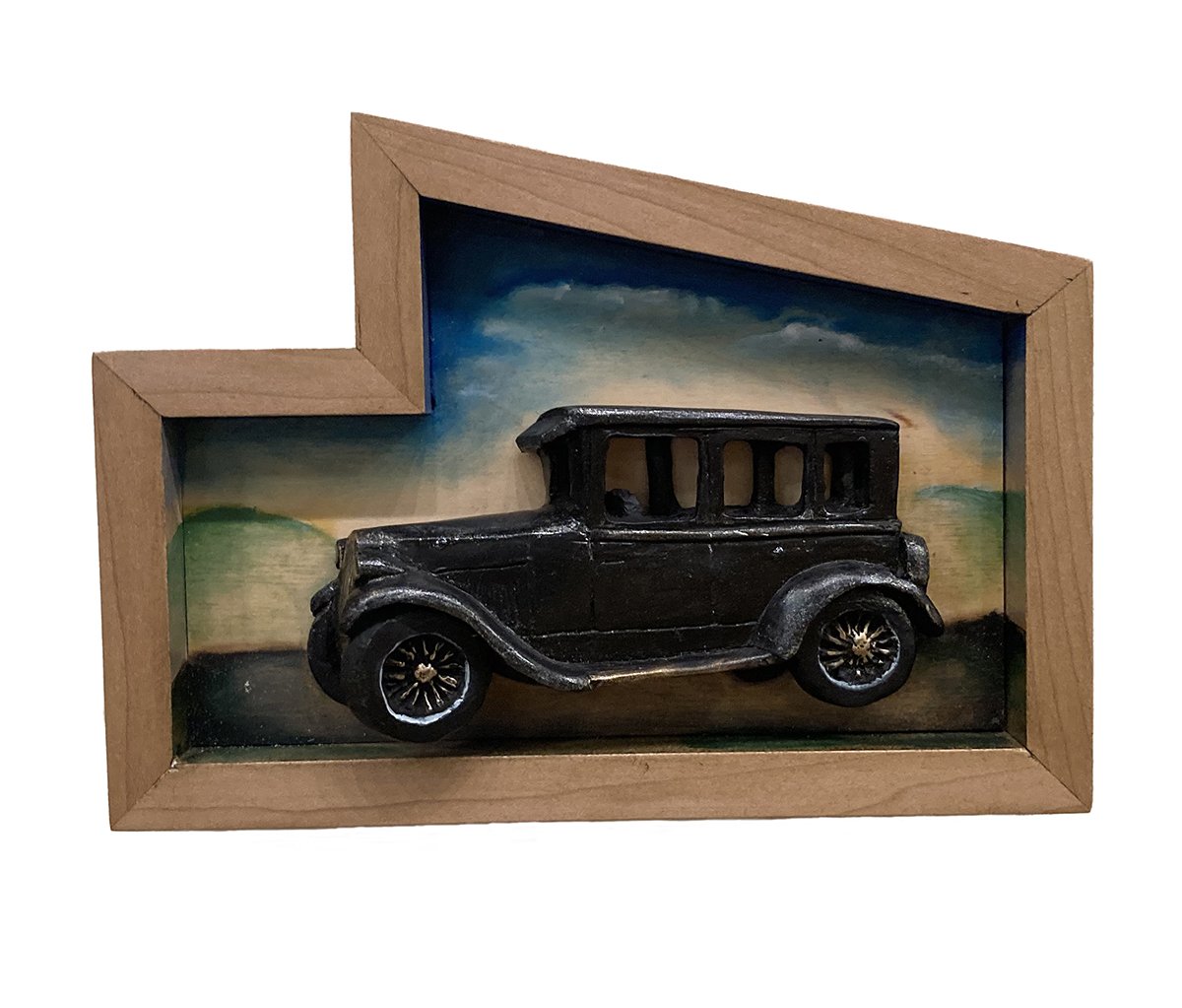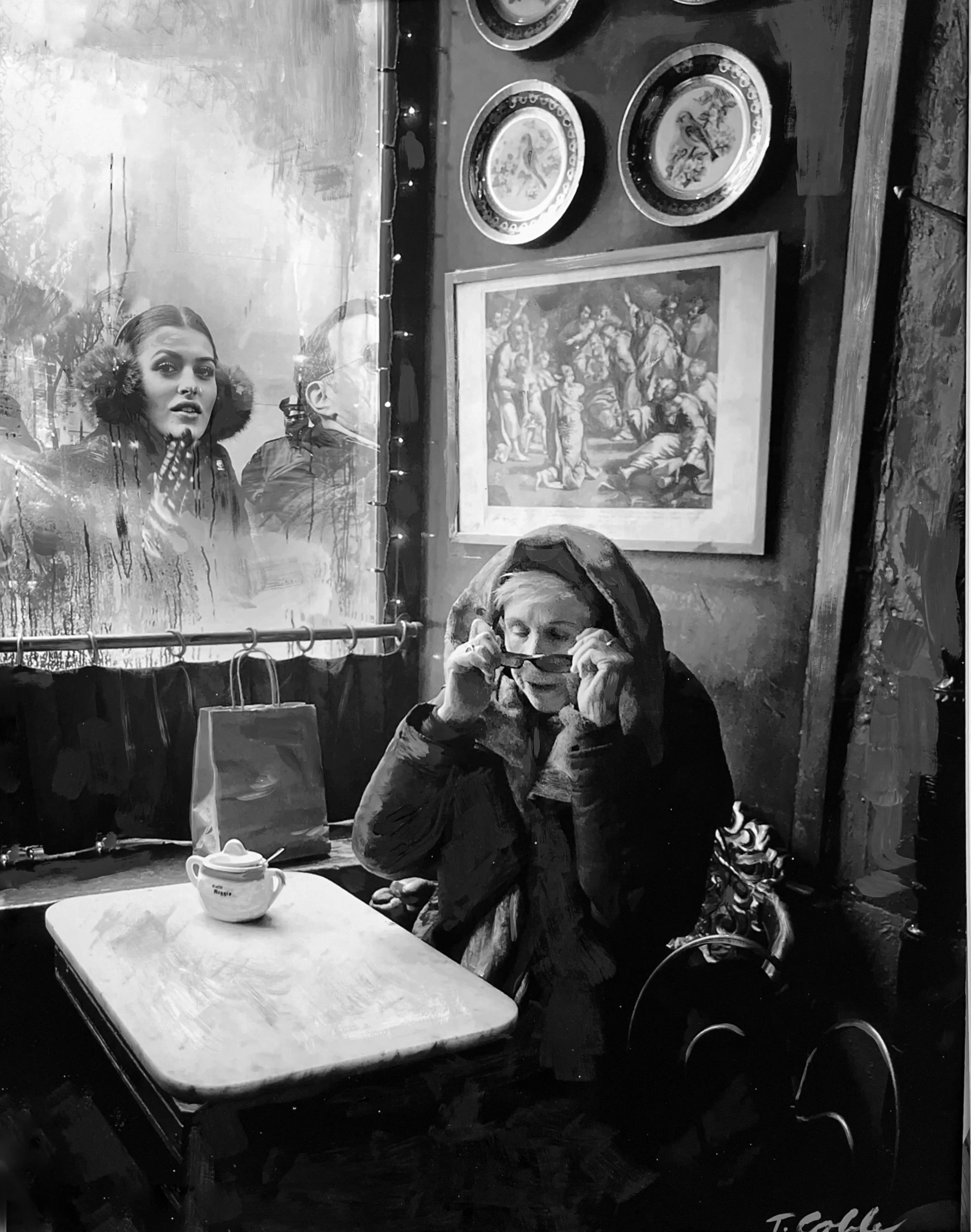Story Line
Susan Cooper: Story Line, A Visual History from Poland to the USA
Anderson Academic Commons at University of Denver, Upper Level, Dean’s Suite Area
2150 E. Evans Avenue, Denver, CO 80208
September 27, 2021-June 30, 2022
Review by Mary Grace (MG) Bernard
Susan Cooper’s installation Story Line, A Visual History from Poland to the USA is a visual autobiography told through the depiction of buildings, ships, houses, and vehicles. It chronicles Cooper’s and her family’s journey from Poland to Los Angeles to Denver. Like Cooper’s storyline, the exhibition has travelled from Chmielnik, Poland to the University of California, Los Angeles and now is on display at the University of Denver.
An installation view of Susan Cooper’s exhibition Story Line, A Visual History from Poland to the USA at the University of Denver’s Anderson Academic Commons. Image by Mary Grace Bernard.
Cooper has lived in Denver since 1975. If you live in the area, more likely than not you have passed by one of her public art installations while roaming through the city. According to the artist, her work takes a personal view. She says her practice offers “new perspective[s] on imagination, perception, and life…[and] often addresses life cycles, changes in time and place, and the nature of art itself.” [1] Cooper typically focuses on subjects of domestic scenes through mediums such as bronze reliefs, mixed media sculptures, and public art.
A view of Susan Cooper’s Periodic Story Line works in the exhibition Story Line, A Visual History from Poland to the USA. Image by Mary Grace Bernard.
The artist conceived of Story Line in 2016 after “visiting sites, including the home where [her] mother was born in Bedzin, Poland.” [2] The installation is located on the upper level of the Anderson Academic Commons—DU’s library. It is divided into four sections, beginning with forty-five bright neon Plexiglas panels of various colors titled Periodic Story Line, followed by forty painted bronze works, a diagram, a collection of drawings, and finally a collection of family photographs and heirlooms. Together, the entire installation places Cooper’s family history within a macro timeline of Polish Jewish history while highlighting her and her family’s movement through the century, geography, and economics. By mixing macro and micro timelines, the artist intertwines histories to keep her and her family’s memories alive for her descendants and viewers. [3]
Susan Cooper, Sniadowo (18th Century Shtetl Synagogue, destroyed in 1939) from Periodic Story Line, 2019, laser-cut Plexiglas. Image by Mary Grace Bernard.
Cooper begins her narrative with the architectural façade of a seventeenth century Shtetl Synagogue, and six others like it (as well as thirteen more in the Plexiglas works) that were destroyed in 1939 during World War II. It ends with her current art studio and home in Denver. [4] The Plexiglas panels and bronze reliefs depict identical subject matters (i.e., the façades of buildings, ships, houses, and vehicles), but do so in differing ways. The brightly colored Plexiglas panels are exhibited in three rows of fifteen on a curved wall and follow a linear timeline. They vary in colors of blue, green, pink, yellow, and orange. The Plexiglas’ transparency and the shadows they create on the wall behind them give the architectural façades a ghostly quality. The panels suggest the ephemerality of time and reinforce that several of the buildings now only exist in memories. Only the etchings in bright yellow glow.
Works from Susan Cooper’s Story Line series, 2019, bronze, maple, and acrylic. Image by DARIA.
The bronze reliefs do the opposite. Instead of alluding to the fading of time, objects, people, and memories, the sculptural bronze works imply “the everlasting,” or even a memorial in commemoration of a fallen hero or traumatic event. In effect, the bronzes ensure that Cooper’s family history and memories will last. Furthermore, these works are arranged by each relief’s shape and as a result create a timeline that moves up and down, backwards and forwards. The bronze reliefs’ disorderly placement encourages viewers to match them with the intimate stories Cooper shares in the exhibition catalog.
Susan Cooper, Grandma’s first car, Fort Worth, Texas, from Story Line, 2019, painted bronze relief, maple frame. Image by Mary Grace Bernard.
For example, the tenth bronze titled Grandma’s first car, Fort Worth, Texas describes how “The family left Ellis Island for Fort Worth, Texas, where Grandma’s sister, Baila lived. Baila and her husband, Abe, immigrated after a soldier shot their young daughter while she [was playing] in a field with friends. She ran home to show her mother what had happened before falling to the floor, dead. In 1931, the family traveled to Los Angeles in this Model A car. Only Grandma drove this car.” [5] As a combined whole, the Plexiglas panels and bronze reliefs demonstrate the various ways time and memory manifest themselves.
Reproductions of Susan Cooper’s family photographs in a display titled The Artist’s Family. Image by DARIA.
The inclusion of a dozen family photographs and a few family heirlooms (in addition to the intimate stories Cooper shares in the exhibition catalog) are the icing on the cake. These elements drive the installation’s intimacy. When looking at Cooper’s family photographs, heirlooms, and the short descriptions that accompany them, viewers feel a stronger sense of connection to the artist’s family. Viewers are able to imagine the lives they lived in addition to each person’s emotions of pain, happiness, sadness, and more.
Portrait of the Lefkowitz family before they left Europe. Zelda (1916-2014, Cooper’s mom), Dora (1903-1984). (Top) Charlie, Rose, Hala, Gitel Raisel. (Middle) Paul, Dora, Grandpa Nathan with Zelda on his lap, Motek, Jacov Fiszel, Hugh. (Below) Hank. Image courtesy of Susan Cooper.
The audience can imagine the sweet moment in the early-1900s family portrait where Gitel sneaks a smile whilst everyone else keeps a stern demeanor. [6] Another photograph shows the family just before they board SS Mount Carroll to Ellis Island in 1921. Everyone has their coats and hats on. The three boys look angry since they were possibly forced to stop playing and sit still for a photograph. These family photographs and heirlooms create a direct link to Cooper’s family’s story; for viewers are able to see individuals’ faces and ponder the objects they held in their hands.
Upon writing this article, it took me some time to reflect on Cooper’s work and the emotions it brought up for me due to the installation’s highly personal and intimate retelling of the artist’s family history. According to Cooper, “Everyone has a story. Each is personal yet also universal because we all have history.” [7] Through the representation of architectural façades, written accounts, and heirloom photographs, Story Line recounts the terrifying and stressful history of Cooper’s family escaping the Holocaust, immigrating to the U.S. through Ellis Island, overcoming animosity, and thriving as American citizens.
Mary Grace Bernard (MG, she/her) is a transmedia and performance artist, educator, advocate, and crip witch. Her practice finds itself at the intersection of performance art, transmedia installation art, art scholarship, art writing, curation, and activism.
[1] Susan Cooper, Story Line Exhibition Statement, “Artist Bio.”
[2] Susan Cooper, Story Line Guide, “Artist Statement,” p. 25.
[3] Susan Cooper, Story Line Exhibition Statement.
[4] At the University of Denver library, Cooper found a book by Maria and Kazimierz Piechotka, “a Polish couple [who] in 1959 [published] a book on synagogues that were destroyed in 1939 after centuries of existence. Their research was based [on] photographs and documentation [taken] by Szymon Zajcyk, who was murdered during the Holocaust.” This book inspired Cooper’s body of work Recollection and the opening of Story Line’s timeline. The word “shtetl” is Yiddish, and it means “little town.” Shtetls were small market towns in Russia and Poland that shared a unique socio-cultural community pattern during the 19th and early 20th centuries.
[5] Susan Cooper, Story Line Guide, “10, Grandma’s first car,” p. 9.
[6] In the Story Line Guide on page seven, Cooper explains that because Gitel’s husband had asthma, he could not get a visa to the U.S. Gitel refused to leave her husband behind. Cooper continues, “Gitel and her family were most likely forced into the Bedzin Ghetto in 1943. Motek, their oldest child, joined the Bedzin Ghetto Resistance. The uprising was defeated in August 1943. The family was probably murdered in the Ghetto in 1943. There is no record of them.”
[7] Susan Cooper, Story Line Exhibition Statement. A video interview and tour of the exhibition with the artist is available here.














